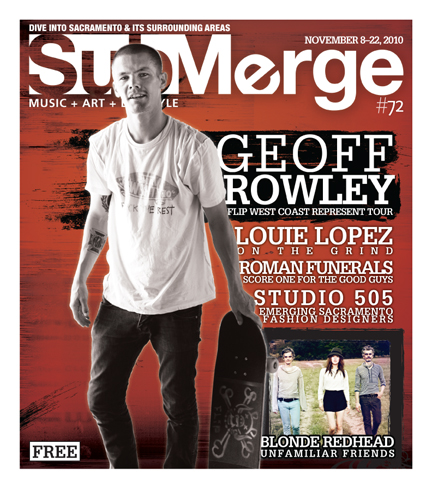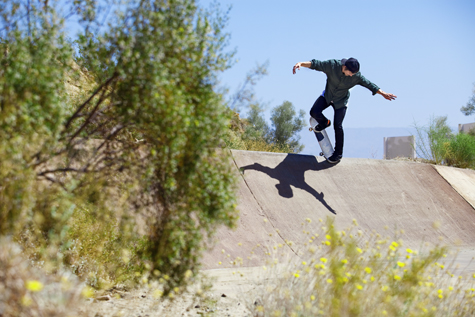The symbiotic relationship between skateboarding and the arts formed almost from the sport’s onset—the street culture that skating emerged from was one of such complete freedom of creativity that it was inevitable that art would eventually permeate every pore of the industry. The skill and dedication necessary for both are just as indistinguishable, from the tireless hours spent landing and perfecting a trick, to the focus, patience and imagination it takes to erect a piece of artwork, both disciplines seemed destined to unite.
For Stefan Janoski, a local legend of sorts who honed his prowess on the board on the streets of Sacramento with the likes of Brandon Biebel and Omar Salazar, these worlds collided decades ago, too. A professional skateboarder known for his effortless, laid-back approach to some of the gnarliest tricks in the book, Janoski has been painting and sculpting since before he landed his big shoe contract with Nike and launched his eponymous sneaker line in 2004.
“I was into art before I was even into skating,” Janoski admits. “When I was a kid and they [asked], ‘What do you want to be when you grow up,’ I said I was going to be an artist. When my sister taught me that they’re called ‘starving artists,’ I would tell everyone I was going to be a starving artist.”
Thanks to the skate culture’s voracious appetite for celebrity sneakers, and a solid deal with a titan shoe company, Janoski’s able to work on his artistic endeavors without having to rely on the local soup kitchen for sustenance.
Local skate fiends and art collectors unfamiliar with the professional skateboarder’s artistic portfolio are in for a treat when Janoski unveils his new body of work, titled Nightmares of Normality, on Nov. 3 at Beatnik Studios in Midtown Sacramento. For Janoski, bringing this show to Beatnik is a homecoming of sorts—it’s only after departing Sacramento for Brooklyn, New York, in the early 2000s that he really began to focus on his artistic yearnings. Seeking refuge from the bitterly cold East Coast winters, Janoski hunkered down and reemerged with a prolific collection of work that many of his family and friends in Sacramento haven’t been privy to until now.
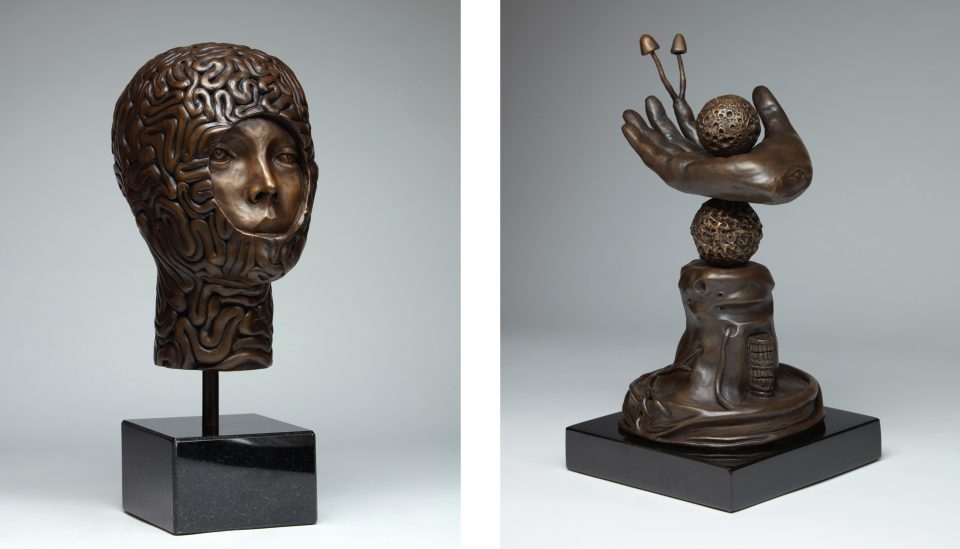
The bulk of the work in the upcoming show is from those prolific days in his Brooklyn warehouse—a space so massive in scale that the work born from its brick confines reflects the enormity of the space in which they were created.
“You know in New York the winters are very cold, so it’s a great place to do art if you want to stay inside for months,” he says with a chuckle. “I was going on [tour] at the same time, but when I was there I would just be in the house making stuff. I started trying to make, like, really tall papier-mache guys, but that didn’t really turn out, so then I just started hanging huge canvases on the walls and just painting. I just had all of these funny little ideas and I thought they’d be even funnier if they were big.”
Janoski’s work is a menagerie of mediums, scales and techniques. He comfortably shifts gears from the skatepark to the music room—yes, he even finds time to write and play music—to the easel. But it’s the solitary nature of his work that fuels the creative process and breathes life into his creations—introspection, rather than inspiration serves as its catalyst.
“A lot of it’s what’s going on in my head, [and] of course reflective of what’s going on around me,” he explains. “I mostly just either think of something that I’ve never seen that I would love to see, or I have [a specific] idea or sometimes I make stuff for no real reason and then it ends up going together with something else. There’s lots of different ways my pieces emerge.”
With exhibitions in New York, London and Hong Kong, it’s only fitting that Janoski bring his work back home to share with those who have supported both his skating career and creative endeavors since way back in the day, especially with a body of work that shows the evolution of his mediums from sketches to painting to sculpture.
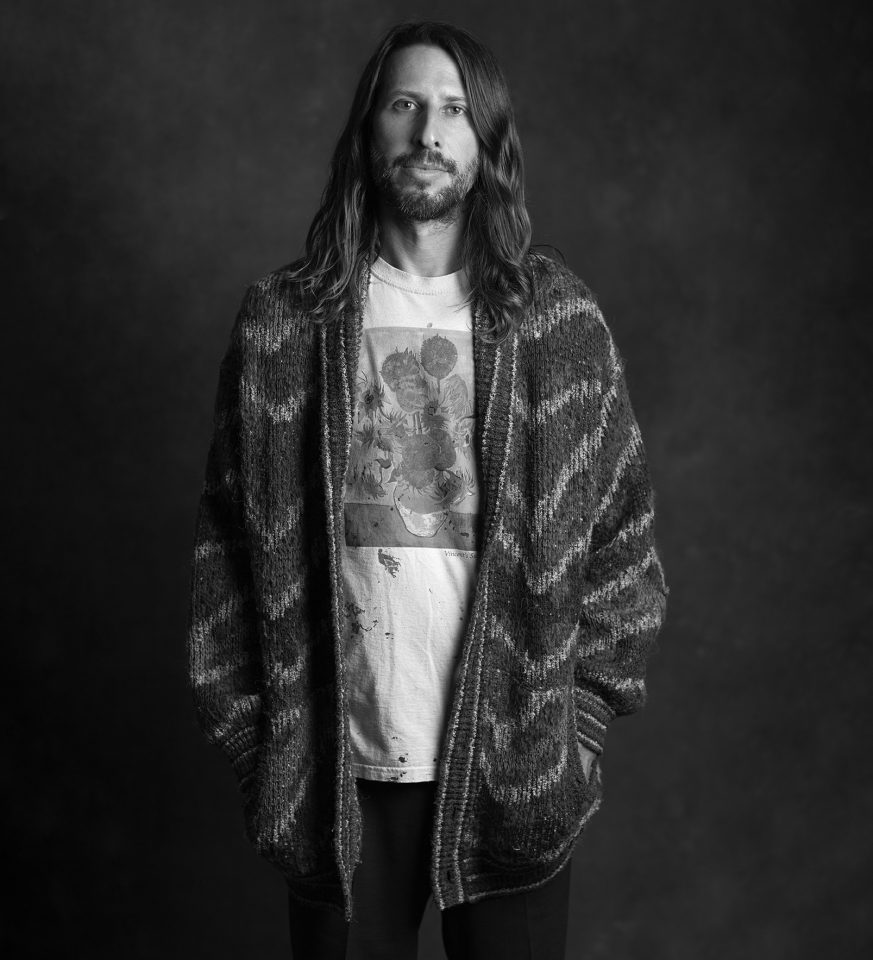
“I had always sculpted, but not very much. I was always much more into paintings and stuff, and then I just had these ideas that I thought would be better as sculptures,” Janoski says. “When I made them, I was like, ‘I’m going to cast them in bronze and do the whole thing.’ Once I did that I loved it. Then all of my ideas became three-dimensional after that. I didn’t even have painting ideas any more. That’s all I’ve been doing for years. I mean, I still do the paintings and drawings and everything else, but mostly when I’m going out to the art room I just sit there and sculpt.”
From the expansive canvases that were born out of the frenetic energy of New York, to his growth in the sculptural arts, Nightmares of Normality will feature work that moves from his commentary on family, to more abstract themes dealing with religion.
“I just learned through trial and error. At first my armatures were not sturdy,” he admits. “I made the sculptures and then had to drive them to the foundry in Queens, and I’d be in the car holding this sculpture that’s wobbling around. The roads in New York have the biggest potholes, so the whole drive me and my wife would be hectically trying to get there without ruining the whole thing. It’s pretty funny, but now I’ve gotten a lot better, so they’re pretty sturdy.”
The upcoming show will showcase seven or eight of the expansive pieces made within the frigid confines of his Brooklyn warehouse as well as a collection of bronze sculptures ranging in size from miniature to colossal. Nightmares of Normality will also feature the work of skateboarder-turned-artist Joe Castrucci, who collaborated with Janoski on several pieces. Castrucci also happens to be of the owners of a skate company that sponsors the skater-cum-artist.
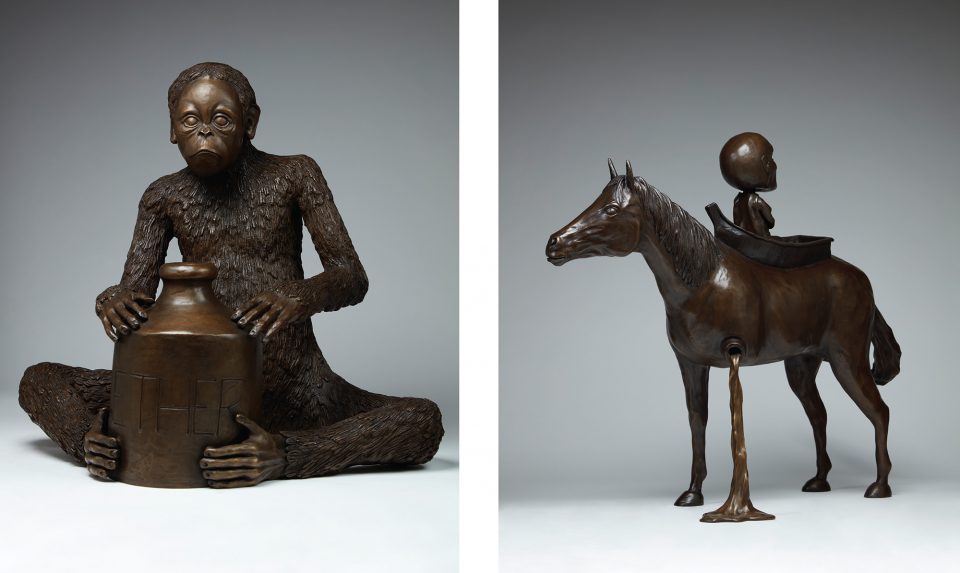
“It’s actually going to be a lot of art, and then Joe Castrucci, who is the owner and the artist behind Habitat Skateboards, made graphics of my sculptures,” Janoski explains. “The art he did for the show is actually based on my art, so there’s going to be skateboards with his graphic interpretation of my sculptures, which is pretty cool.”
Setting up the show was a concerted effort between Janoski, Wes Davis of Beatnik and Castrucci. After all, Janoski currently resides in Los Angeles with his wife, so collaboration was an elemental component of bringing his work back to his native haunts. After delays in coordinating the effort, Janoski credits the team for finally enabling him to bring the work he has amassed during his time away from home.
“I was going to do an art show out here [earlier] but it fell through, so I was talking to Wes, who is my old friend, and [as] we started planning this show, I said, ‘Hey, I have all these paintings and all of these sculptures I did out in L.A. as well,’ so we just figured, like, ‘Hey, let’s just put it all in there.’”
Concepts can get heavy when you talk about art, especially when you’re dealing with the size of bronzed sculptures. But bringing a sense of levity to the work is an important component of the creative process for Janoski.
“I like to have a good sense of humor,” he admits. “I like to take things that are considered serious but show them in a way that shows they’re not serious if you [really] think about it.”
The opening reception for Stefan Janoski’s Nightmares of Normality will take place at Beatnik Studios (723 S St., Sacramento) on Nov. 3, 2017, from 6–9 p.m. For more info, go to Facebook.com/beatnikstudiossacramento or Beatnik-studios.com. The exhibit will be on display until Nov. 22.
**This article first appeared in print on pages 18 – 19 of issue #251 (Oct. 21 – Nov. 6, 2017)**
The Art of Being Fluid
While skateboarders across the world might regard him as a living legend, San Francisco native Tommy Guerrero doesn’t want that label for himself just yet.
“I hate that the term is thrown around so loosely,” he says over the phone. “And secondly, it’s usually used when people pass on. It’s like, ‘Fuck, I’m still here!’”
Instead, Guerrero—now a 49-year-old father of one—prefers to keep rolling with what he’s always known best: skating and music.
During his tenure as a professional rider and competitor for Powell Peralta’s Bones Brigade skate team in the ‘80s, Guerrero says he would always make time to come home and play his bass “for hours on end.” Although Guerrero currently serves as an art director for Krooked skateboards, as well as a member (but mostly an ambassador, he says) of the Converse CONS pro skate team, he’s also grown into a multi-instrumentalist who plays guitar, keys and percussion, in addition to bass.
Music, he explains, was a childhood passion that he began taking seriously as early as 1978, when the Ramones came and put on a show in front of San Francisco’s City Hall.
“It changed my life,” Guerrero says. “Being a skateboarder was already kind of an outlaw, rebel thing to do. And the punk ethos went hand-in-hand with skating … So me and my brother instantly were just enamored.”
Skating by day and rehearsing by night, Guerrero ended up forming a few different punk bands throughout the ‘80s—Free Beer perhaps being the most well-known. As a new decade trickled in, however, Guerrero says his band-playing days slowly came to an end while his skating career soldiered on. But that didn’t mean he was done with music.
Investing in a drum machine and a 4-track recorder—the very first Portastudio, as he recalls—Guerrero continued recording his own tunes, until eventually he got featured on a jazz compilation album in 1995.
Around the same time, Guerrero also provided the soundtrack for a skate video in promotion of a clothing company he had started called Forties, which caught the attention of Galaxia and Mo’ Wax Records. Guerrero produced three projects under those two labels at first, and then a slew of others throughout the 2000s and 2010s—he now has 11 albums in the bank, according to his website.
His latest release, 2015’s Perpetual, is an extension of sorts to the album prior, No Man’s Land, which he characterizes as a “break-beat spaghetti-western noir.” Both albums stem from desert rock and world music influences, including Tinariwen, Bombino, Gabor Szabo and John Zorn, among others.
Now, about six months after Perpetual dropped, Guerrero is embarking on a very brief tour up north to Oregon and back down again to San Francisco: a “run,” he calls it.
“This is just to go and play some music,” he says, “just to go do something, really.”
Before he stops off at the Shady Lady Saloon later this month with drummer Chuck Treece and bassist Josh Lippi, Submerge was able to chat with Guerrero about music, skateboarding and his surprising ties to Sacramento.
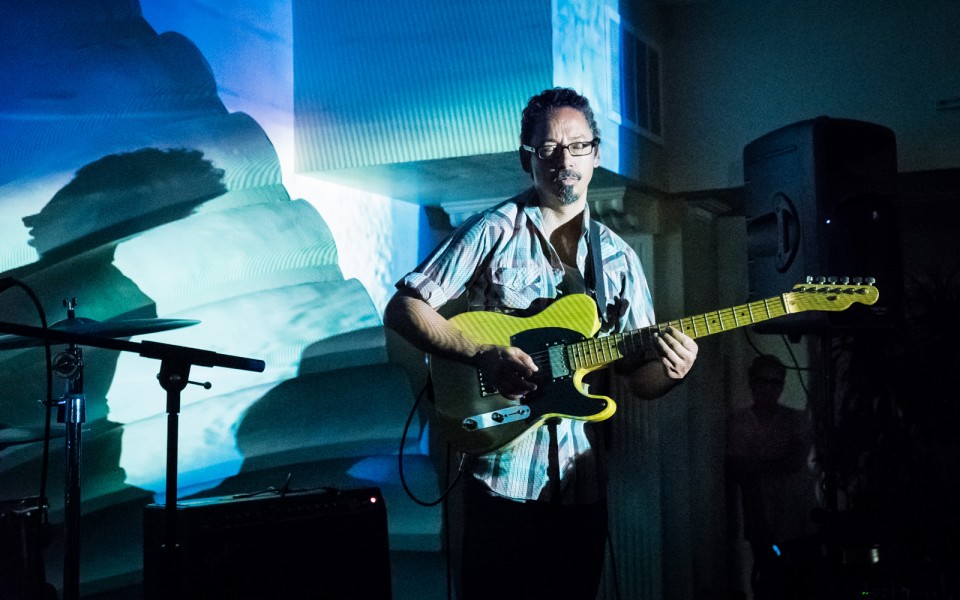
Photo by Claudine Gossett
Would you consider your music to be tailored toward skateboarders, or that specific culture at all? Or is it just music for a general audience?
Music is for anyone, just as anything is. And I really can’t stand the way people need to pigeonhole you so they can market you in a specific way. That’s what so many people try to do in the music world … which I don’t agree with. It’s either art, or not. And it’s either good or bad, you know, depending on your taste … And, you know, I get a lot of support from the skate and art and surf community, which is great. I love it, that’s my family. But I would hate to be limited to such things, because I’ve met people anywhere from, literally, 5 [years old] to 65 who dig my music. It’s for everyone and anyone.
Would you say that your musical style is along the same lines as your skateboarding style? Your music, to me, has somewhat of a laid-back, free-form feel to it. And your skate style also seems very free and loose, but fast-paced at the same time.
I think the correlation is more about being in the moment. The thing about street skating … everything is in the moment. It’s very off-the-cuff; you’re improvising as you go down. You see a curb, you hit it. You see a stairwell, you see a driveway, you see a bench. Whatever it is, you’re hitting it along the way. And none of this is pre-planned. So music is kind of like that for me … I just want everything to be fluid and seemingly organic and seemingly natural—not forced. And that’s kind of how I approach everything. But I think that’s kind of the thread within skating.
I’m curious to know if you ever wish you were as well-known or famous for your musical prowess as opposed to your skateboarding career.
No. I identify myself, if I have to, as a skateboarder. And that’s just fine. The music thing for me—I’m not looking for accolades from that world. I don’t even really orbit in that world or have anything to do with the music industry. I’m removed from it, which is fine.
Is there anything you wish you could change about the music industry as a whole? Other than the blanket labeling and branding, I mean.
My only thing, truly, with the business end of music is that it would be nice if the people who are trying to run the industry would understand that without the artists, there is no art. So by not paying them what they deserve for their art, or their product or whatever people want to call it, it’s doing a huge disservice to the community. Even [for] people who have my music and dig it. You know, I’ve had people tell me, “Oh, I love your stuff. I just downloaded it from blah blah blah.” And it’s like, “Cool. I’m glad you dig it. It would be nice if you supported me financially.” Just because of the cost of making a record … The cost of me recording, the mixing, the mastering, the art and design and then the final production of the CD or vinyl and/or a digital release [is high]. There’s lawyer fees, publishing fees—it all adds up. I mean, I can’t get away with making a record for less than $10,000 … It’s always difficult to get people to understand that in this day and age, with technology being what it is. Everyone just thinks that music comes out of the ether into their computer somehow, or into their phone. And they don’t even think about the creation of it … So that’s just my thing—trying to get people to be aware of supporting these artists.
I wanted to ask about Sacramento a little bit. Why was Sacramento included on this run? And also, what are some memories you have of Sacramento, if any?
Well, of course I’ve been to Sacramento—many, many, many times. But the idea as we’re coming back [to California]—because we’re gonna hit Bend [Oregon] first, then Portland and then Medford—was to have sort of a stopping point. And since Josh is from Sacramento … why not just play [there]? I’ve never properly played a gig in Sac, and I thought it would be fun. And I know so many skaters there—just so many people—that it just made sense. I grew up in San Francisco, and so we knew a lot of skaters from Sac. We’d actually go up there and skate all the time.
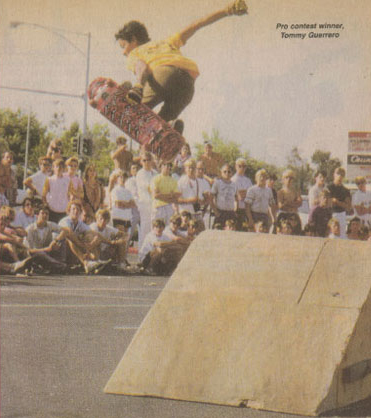
{Photo courtesy of Thrasher Magazine, July 1985}
Wow, really? Any specific spots you’d skate back then?
Not specifically. There were some curbs, some banks. I forget the names of them. But in 1985, Sacramento held a street-style skate contest … I think it was my third street contest ever. And I turned pro there. And that was sort of the launching pad to everything I do with skateboarding. So I turned pro in ’85 in the Tower Records parking lot [off of Watt Avenue]. And what’s interesting is that they just did the Tower documentary … So that was super cool to be part of that, kind of coming full circle. I have a photo of me in 1985 standing in Tower Records next to a stack of Thrasher magazines.
That’s amazing! So you’re saying that contest in Sac was the turning point in your skate career?
Yeah, it was. Because I won the contest and turned pro. And then the next year my [Powell Peralta] board came out and everything happened. So yeah, I know a lot of cats up in Sac, all the old skaters.
See Tommy Guerrero live when he and his band play the Shady Lady Saloon on April 22, 2016. Soak up good vibes, great drinks and copious amounts of old school skater cred. Shady Lady is located at 1409 R Street in Sacramento. For more info, go to Shadyladybar.com.
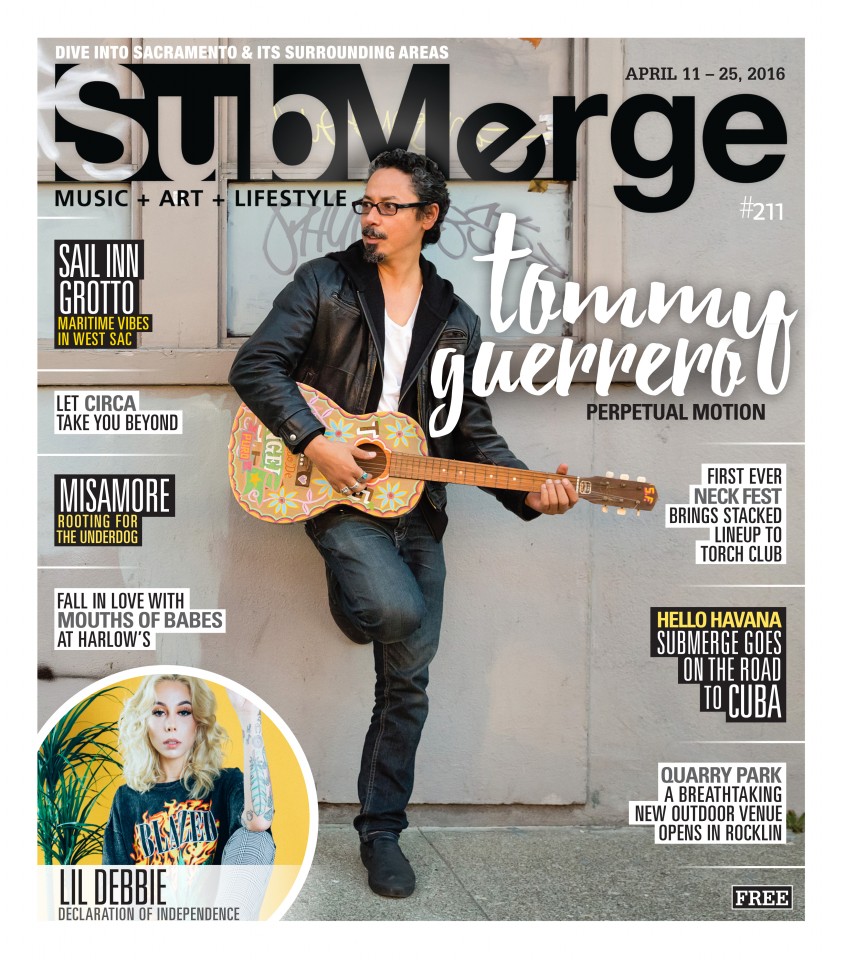
Local pro skater and longtime musician Matt Rodriguez has a style all his own
For having had such a long, successful career as a professional skateboarder, going on trips around the world to film countless videos, landing in magazine spreads left and right, co-founding a popular footwear company called iPath, all while earning what many might call “legendary status” along the way, Matt Rodriguez is a really mellow, surprisingly normal guy. In fact, when Submerge arrived at Rodriguez’s Midtown house in early January, we found him in his backyard shoveling dog poop. See, pro skaters are just like you and me.
One major difference between Rodriguez and the rest of us, though, is that the remainder of his yard, the part not covered in dog doo doo, is made up of a custom skate park with ramps built from salvaged wood.
“It was kind of like a scavenger hunt,” Rodriguez said of his lengthy search for re-usable lumber. Although extremely well built, the ramps are steep and gnarly with tight, technical lines; definitely not easy to skate. In a way, that sort of sums up Rodriguez’s style. He’s known for rolling up to spots that to the untrained eye might not even look skateable, but before long he’ll have a couple tricks bagged and will be ready for band practice (he plays drums in local band The Storytellers as well as percussion in a musical experiment called Blktop Project with fellow pro skaters Ray Barbee, Tommy Guerrero and Chuck Treece). A dirty drainage ditch here, a makeshift plywood ramp leaned up against an electrical box there, and Rodriguez can make anything and everything he approaches on his skateboard, no matter how sketchy or unusual of a spot it is, look downright stylish.
Case in point: After an interview sitting with Rodriguez amongst the ramps in his backyard, photographer Wes Davis and Rodriguez set out on one of a couple missions to snap some photos to accompany this article and Submerge decided to tag along. After loading up a couple skateboards and a case of camera equipment into one car, we headed for a bank spot in West Sacramento near Raley Field that Rodriguez wanted to session. “It’s been here for years but was always fenced in, so I couldn’t get to it,” he said of the feature. The fence recently came down so he’s taking full advantage. As we rolled up to the spot, Submerge couldn’t help but notice that the small concrete bank Rodriguez spoke of was literally smack dab in the middle of a dirt field. Not where you would typically think to go to snap a photo of a skater, like, say, somewhere with more concrete.
“This is the story of my career, fucked up spots,” Rodriguez joked.
We arranged three or four long, narrow pieces of wood as his run-up to the bank to gain speed. He’d start in the dirt with his board in hand and would sprint toward the makeshift ramp, hop on his board and then pop a trick on the lip of the bank. Davis lined up the shot from a number of angles, at times getting down and dirty laying flat on the ground to get the proper vantage point.
“Sometimes you’ll be at a spot for hours trying to get a shot,” Davis said of the tedious art that is photographing skating.
Lucky for us, Rodriguez was on this particular day and half-an-hour or so later we had a few keeper shots, some of which show the Tower Bridge directly behind Rodriguez mid-trick. We’d captured two Sacramento icons in one shot, a success indeed.
After the dirt field bank spot, we headed around the corner to an entrance near the ballpark and immediately started, pulling pieces of plywood off of nearby lumber piles, building a makeshift launch ramp and a landing with a tall obstacle in the middle for Rodriguez to olly over. You know, another typical Rodriguez style set-up consisting of randomly found wood and obstacles. Just as we were about done with the set-up and Rodriguez was getting ready to hit it, we heard someone yell at the top of their lungs, “Hey!” and we saw what looked to be like a security guard pointing at us from a distance. We thought nothing of it until we saw him start running, so we scurried back to our car and hopped in before he could give us any shit. Crisis avoided.
“Just like the old days,” Rodriguez said, smiling ear to ear as we sped off, tires chirping.
On the car ride back to his house, Rodriguez spoke of wanting to get into photography, stating that it would be a good way to keep involved in the sport as he gets older. At 35, Rodriguez is surely no young buck, but one look at his part in the recently released iPath team video The Other Ones shows he’s still at the top of his game and likely will not be dropping off the radar anytime soon. “Trust me, I’ve been a part of a lot of videos,” Rodriguez said. “Some I’m proud of and some I’m not so proud of. This one, as a team we did some missions and covered some ground and gathered some good footage. It is what it is, I think it’s good, honest skateboarding.”
In the following interview with Rodriguez, you’ll learn more about iPath and his involvement in the company, his passion for music and how it ties into his skating, his love for Sacramento and tips for growing dreadlocks. Pick up The Other Ones at local skate shops or find it online by searching “iPath The Other Ones.”

What have you been up to lately? What have you been focusing your energy on?
Skate-wise, doing a lot with iPath right now, designing some shoes and trying to scout out some possible new members for the team. We just finished a video, The Other Ones, so just doing that, keeping that fire burning. And you know, music, The Storytellers and Blktop Project. We just did a Blktop tour in Japan.
How was that?
It was awesome, we went for eight days. It was great.
You were one of the original founders of iPath back in the late ‘90s. Since then the company has gone through a couple of ownership changes and it seems like it’s been on a bit of a roller coaster. What is your role at the company now?
Just someone who they, at least the new owners, look at as a headstone basically. Being there from the dirt up, going through all the metamorphosing, to team changes and new owners. Now it’s on its third owner, and hopefully its last. Just being someone who they look to for direction, being a skater, you know, they figure, “This guy knows what he’s doing and has been here from day one.”
I’ve read that Klone Lab, the new owners, want to get the company back to its roots. It’s got to feel good knowing that everyone is on the same page when it comes to realigning the company with it’s original values and image, right?
Yeah, whereas a lot of stuff changed when Timberland bought it. They hired a general manager, he came in and just cut half the team, and the half of the team that he cut were big personalities and a big part of the company, that makes up the vibe. A lot of stuff went through change then. But Timberland came into the situation not knowing who the hell was who in skateboarding. Through the time they had it, it grew and maxed out every year and was showing increasing growth, but I just think it wasn’t enough for them and they had other stuff on their plate. They actually sold Timberland, so the good thing is that they put iPath on the market for someone to take instead of canning it. They could have been like, “We’re over it, sorry.” But they realized that it’s a collective of skaters and artists, and a lifestyle even beyond just skateboarding, and they respected that and they wanted to give it a chance for someone else to take the time and energy. So Klone Lab stepped in.
It’s a tough market out there for small shoe companies, isn’t it?
Oh yeah, you’ve got companies like Nike, even all their pros that they pay to skate for their team combined is still barely a chunk of what they pay Tiger Woods. So skating for Nike, it’s fun, they can have fun with it, but it’s not their livelihood. With something like iPath, from the original investors to the investors now, that’s all they have, they have to make it work. But, you know, we’re just wanting to take more road trips, trying to get articles, making some films, get it all out there and just keep it going. Just keep trying to show the raw side and the soul side of skating.
As a company, especially coming from a grassroots budget, let alone motive, it’s not always easy. We don’t have X amount of dollars to just blow and have fun with, we have to make every dollar count. Granted, not everything runs smooth, even when you have all the dollars to wipe your ass or sweaty forehead with. But nonetheless it’s all about keeping going, nothing is going to be perfect. It’s like a band, sometimes a member gets fed up and can’t take it, or you want to bring a new member in, or someone wants to go in a different direction, or there’s a falling out. Whatever you have left, you have to work with.

The iPath skate team has gone through changes recently and a lot of people were dropped, right? Who is officially on the team now? I read somewhere it is just you, Fred Gall, Kenny Reed and Steve Nesser. Is that true?
Yeah, for right now.
About The Other Ones, there’s a long story behind why it didn’t get “officially” released through iPath, can you touch on that please?
It’s an independent effort from the team, because at the time iPath knew people were going to have to be cut, and they didn’t want to put it out as “the iPath video” and then a month later, half the team is gone. So for now, for our individual talent and credibility, the video is out. It’s out there as opposed to out of sight, out of mind. The team got together and were like, “Fuck it.” iPath still put in some money to produce it, most of the footage in that video is from iPath tours, so iPath is still a big part of it.
The song during your part, you recorded that right?
Yeah that was me and Tommy [Guerrero], that was just on the cuff. I was like, “Yo I want to come down and throw down a rhythm.” We set up the mics and just fucking went for it. He had a bass line and we just did layers.
Is this the first time you’ve recorded a song for a video part of yours?
No, I’ve done that before, but it was all percussion. This one was percussion, Tommy on bass, a little guitar, some melodica, some shakers.
Is that something you’ll continue to do? Not a lot of skaters can say, “That’s my song during my part.”
I figure whatever I have to offer, you know? I’m going to need a song, why not throw down a little something?
How old were you when you started playing music? What instruments were you first drawn to?
In fourth grade I definitely was tearing down boxes and buckets and banging away on anything I could get my hands on. We had an extra room and I lived on Madison and Sunrise, and it was like all around me. I just had like boxes and buckets and pans. I’d play with my mom’s coat hangers, I’d snap them so I had sticks. I finally got my first drum set when I was in sixth grade.

So it was percussion that drew you in?
Yeah, basically. Drumming and time, rhythms and patterns. I like how physically demanding it is, like skating. That’s what attracted me to skating, because I used to break dance when I was young in San Jose. So when I first seen skating…
Wait a second, that didn’t come up in my research! How into break dancing were you? And how old were you?
I’d go to battles, me and my older brother.
I was like 7 to 10 years old. Then I found my first skateboard when I was 10-and-a-half.
You found the board in one of your grandparents’ closets, right?
Yeah, my grandpa’s closet. It was my older brother’s, but I’d never seen him ride it. I was like, “Sick! Something to roll on!” From then on I met skaters, and they showed me Thrasher mag and who were the dudes. I was like, “Oh sick, there’s a whole world here.” I was captivated.
You’re 35 now and still going hard in such a physically demanding sport. How do you keep your body and mind so healthy and fit? What are your secrets?
It’s just will. I don’t ever see myself just being like, “Ugh I’m too old,” or mad I’m not getting paid, or being sent around to do demonstrations. I’m going to skate, go find a ditch and have at it.
You skate with your trucks ridiculously loose. What’s that all about?
Jeff Toland and Ricky Winsor and Sam Cunningham, so many amazing guys like that, I naturally gravitated to it because I grew up seeing it. Those dudes literally schooled me, I was basically blessed to grow up with those guys. They were raw, they rode their trucks super loose, they didn’t give a shit, they were like, “Fuck you, we’re skating! Don’t talk shit or we’ll caveman the side of your car’s fender.” They were just so raw. You know, back in the day learning flip tricks and whatnot… You evolve over time, your skating may change. I definitely realized my skating was changing and wanting to do something different. I always want to do something against the grain, you know. I get sick of seeing the same redundant shit out there. As far as skating with my trucks loose, that was just more of a way to be like, “How can I make my circumstances more screwed up and still pull it off?” Back then, they weren’t doing the tricks that are around today, but nonetheless, it’s possible. So I slowly worked my way looser and looser.
And now your trucks are barely on your board…
It’s a challenge, yeah. My board’s fucked, but I’m still rollin’ away!
Have you always called Sacramento home?
Pretty much, yeah. I moved here when I was 11-and-a-half. Grew up all around skating, knowing different skaters around the perimeter, downtown and all the outskirts. I moved back to San Jose when I was 16 for two years only to realize I just loved it up here, all the trees–the people, the pace, just the vibe, you know? The seasons, you can actually see them. And just the people, the friends I met through skating here. So I moved back after high school. I’ve been here ever since. I go around the world, I’ve seen a lot of beautiful places, but when I’m coming home to Sac, I’m like, “Ah man, good old Sac.”
Lastly, how long have you been growing those dreads?
Oh, this mop? Seven years. The secret to fast-growing, long hair is to eat a lot of beans. Lentils, peas and kidneys, it’s all the calcium.
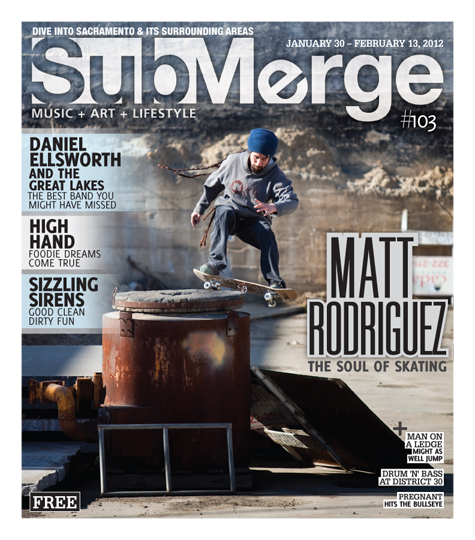
Learn more about iPath at ipath.com. Pick up The Other Ones at local skate shops or find it online by searching “iPath The Other Ones.” Learn more about Blktop Project at Galaxiarecords.com/album/blktop-project. Look for upcoming Storytellers show dates at Facebook.com/sacstorytellers and expect a new album later this year. That Rodriguez, he’s a busy dude.
Geoff Rowley on Skateboarding…Mostly
If you know anything about skating, you don’t say “who” when Geoff Rowley’s name is mentioned, nor do you casually agree to an interview with him. The proper reaction should be similar to the yells and panty tossing that boy bands typically receive… or a cavalier, but cool reply of “gnarly.”
Rowley was Thrasher magazine’s Skater of the Year in 2000 and one of the few blokes lucky enough to have a trick named after him, the Rowley Darkslide, a variation of a trick created by the great Rodney Mullen. Rowley’s legendary video parts showed him going huge since 1994, back in Liverpool before he jumped the pond.
Now of the old guard, he’s bringing his tour to Sacramento, tearing up B-Street Skate Park on the Flip West Coast Represent Tour. The tour features pros and amateurs of the Flip team, including Curren Caples, Andrew Langi, Lance Mountain, Luan Oliveira, David Gonzalez, Ben Nordberg, Rune Glifberg and Louie Lopez (also featured interviewed).
Rowley’s name rings in the urban jungle and in the actual jungle. In fact, a hobby of his is to track big game in the wild. This juxtaposition of interests was the source of my intrigue, thus it was my first question for Mr. Rowley.
When did your fascination with wild beasts start?
I probably couldn’t put an age to it, but just before my teen years my friend, who I skated with, was friends with the chief game warden up north of England. I’d been skating with that guy so much, and he’d been skating since 1972, so he was a lot older than me. But I had fun skating with him, got on a roll with him. We were into all the same skaters–shit like that. So I ended up hanging out with him outside of skating. We went up into the north country of England one time and just enjoyed it–basically stalking deer. That’s kind of where it started. I’ve been doing it for over 20 years since then.
Do you have any stories of you hunting/stalking trips going awry?
No. I wouldn’t say anything’s been that close. I’ve had friends who have been in some bad situations. This is about skateboarding; what’s going on here?
Have you ever skated in Sacramento? What’s your favorite spot here?
Hundreds of times, all over the city, even way up in Placerville. I know the area really well. John Cardiel and Omar Salazar are from out that way. I’ve skated with those guys many times.
I wouldn’t say I have one favorite spot. There was this one rad car park with…barriers on the top, but they took it out. It was pretty rad and unique. A lot of the stuff downtown when I was first going to Sacramento, you can’t skate anymore. Downtown isn’t really skateable.
There’s good stuff in Davis. All over the place. It’s a big suburban area with a lot of skate parks. So there’s plenty of good stuff to skate with a good scene as well.
Do you have any plans to continue the Sorry series?
We just finished the third video last year, which was Extremely Sorry. It was only kind of intended to be a trilogy. So I would say we’re moving forward now as far as any other videos we’re working on in the future. They’re going to be new and fresh. It’s important to evolve. We had fun with that and that was a chapter of our company, but it’s reinvigorating to have a new start. Change is good. Unless we’re talking about Obama, then change doesn’t appear to be that good so far.
Do you want to make this a political discussion?
No I don’t.
Would you care to say a few kind words about Louie Lopez, since he’s joining you in Sacramento?
You can’t say anything but good things about that kid. He’s rad and super progressive. The raddest thing about Louie is that he smiles. He loves it and that’s going to take him to the end of the earth. If I could have one young kid riding for Flip as an amateur, it would be Louie Lopez.
He’s constantly learning new tricks and out skating all the time. He lives in Hawthorne, Calif., so he’s around a pretty good scene. There are a lot of kids that skate. A lot of kids don’t have a lot of money in that area so they’re a little more humble. He’s just around good people, down-to-earth people. It shows in his skating.
There’s a guy who taught his dog to skate. Considering you’re a man fascinated with animals, what animal would you teach to skate?
It would have to be a full-size, maybe 6-foot-long weasel. That’s the only thing that could go fast enough, I would say. It would be the only thing that would have the same kind of control on a skateboard.
Last question. You’re at the Pearly Gates and St. Peter demands you do one trick to get into Skatepark Heaven. What do you pull?
Probably turn around and go fakie.
